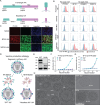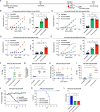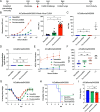Headless hemagglutinin-containing influenza viral particles direct immune responses toward more conserved epitopes
- PMID: 39324791
- PMCID: PMC11495035
- DOI: 10.1128/jvi.01166-24
Headless hemagglutinin-containing influenza viral particles direct immune responses toward more conserved epitopes
Abstract
Seasonal influenza vaccines provide mostly strain-specific protection due to the elicitation of antibody responses focused on evolutionarily plastic antigenic sites in the hemagglutinin head domain. To direct the humoral response toward more conserved epitopes, we generated an influenza virus particle where the full-length hemagglutinin protein was replaced with a membrane-anchored, "headless" variant while retaining the normal complement of other viral structural proteins such as the neuraminidase as well as viral RNAs. We found that a single administration of a headless virus particle-based vaccine elicited high titers of antibodies that recognized more conserved epitopes on the major viral glycoproteins. Furthermore, the vaccine could elicit these responses even in the presence of pre-existing, hemagglutinin (HA) head-focused influenza immunity. Importantly, these antibody responses mediated protective, but non-neutralizing functions such as neuraminidase inhibition and antibody-dependent cellular cytotoxicity. Additionally, we show the vaccine can provide protection from homologous and heterologous challenges in mouse models of severe influenza without any measurable HA head-directed antibody responses. Thus, headless hemagglutinin containing viral particles may represent a tool to drive the types of antibody responses predicted to increase influenza vaccine breadth and durability.IMPORTANCECurrent seasonal influenza vaccines provide incomplete protection from disease. This is partially the result of the antibody response being directed toward parts of the virus that are tolerant of mutations. Redirecting the immune response to more conserved regions of the virus has been a central strategy of next-generation vaccine designs and approaches. Here, we develop and test a vaccine based on a modified influenza virus particle that expresses a partially deleted hemagglutinin protein along with the other viral structural proteins. We demonstrate this vaccine elicits antibodies that recognize the more conserved viral epitopes of the hemagglutinin stalk and neuraminidase protein to facilitate protection against influenza viruses despite a lack of classical viral neutralization activity.
Keywords: HA stalk; influenza A virus; neuraminidase; vaccines.
Conflict of interest statement
Duke University has filed for intellectual property protection of the vaccine production approaches and antigen designs described in this work.
Figures




Similar articles
-
Enhancing NA immunogenicity through novel VLP designs.Vaccine. 2024 Oct 24;42(24):126270. doi: 10.1016/j.vaccine.2024.126270. Epub 2024 Aug 27. Vaccine. 2024. PMID: 39197219
-
Greater Breadth of Vaccine-Induced Immunity in Females than Males Is Mediated by Increased Antibody Diversity in Germinal Center B Cells.mBio. 2022 Aug 30;13(4):e0183922. doi: 10.1128/mbio.01839-22. Epub 2022 Jul 20. mBio. 2022. PMID: 35856618 Free PMC article.
-
H3 hemagglutinin proteins optimized for 2018 to 2022 elicit neutralizing antibodies across panels of modern influenza A(H3N2) viruses.J Immunol. 2025 Jul 1;214(7):1698-1713. doi: 10.1093/jimmun/vkaf092. J Immunol. 2025. PMID: 40400055
-
Neuraminidase inhibitors for preventing and treating influenza in healthy adults and children.Cochrane Database Syst Rev. 2012 Jan 18;1:CD008965. doi: 10.1002/14651858.CD008965.pub3. Cochrane Database Syst Rev. 2012. Update in: Cochrane Database Syst Rev. 2014 Apr 10;(4):CD008965. doi: 10.1002/14651858.CD008965.pub4. PMID: 22258996 Updated.
-
Vaccines for preventing influenza in healthy adults.Cochrane Database Syst Rev. 2018 Feb 1;2(2):CD001269. doi: 10.1002/14651858.CD001269.pub6. Cochrane Database Syst Rev. 2018. PMID: 29388196 Free PMC article.
Cited by
-
Past, Present, and Future of Viral Vector Vaccine Platforms: A Comprehensive Review.Vaccines (Basel). 2025 May 15;13(5):524. doi: 10.3390/vaccines13050524. Vaccines (Basel). 2025. PMID: 40432133 Free PMC article. Review.
-
Administration of antigenically distinct influenza viral particle combinations as an influenza vaccine strategy.PLoS Pathog. 2025 Jan 22;21(1):e1012878. doi: 10.1371/journal.ppat.1012878. eCollection 2025 Jan. PLoS Pathog. 2025. PMID: 39841684 Free PMC article.
References
-
- WHO . 2023. Estimating disease burden of influenza. Available from: https://www.who.int/europe/activities/estimating-disease-burden-of-influ.... Retrieved 1 Jul 2021.
MeSH terms
Substances
Grants and funding
LinkOut - more resources
Full Text Sources
Medical

